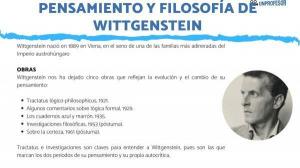Galileo Galilei: most important discoveries
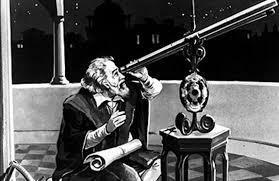
Image: Amino Apps
Throughout history there have been a great number of incredible people, capable of mastering different disciplines and change people's perspective on things that have been believed for years. These people have sometimes had to confront the authoritarian figures of the time to defend their ideas, being an example of this Galileo Galilei. To better understand the importance of this character, today in this lesson from a PROFESSOR we are going to talk about the Galileo Galilei's most important discoveries.
Galileo was a scientist, philosopher and astronomer born in the city of Pisa in 1564. Galileo was throughout his life a man linked to the scientific revolution and the Renaissance, being one of the main advocates that science should evolve, abandoning the stagnation it had suffered over the years previous.
As a good Renaissance man, Galileo was attracted to many disciplines, so he did not specialize in any particular field, showing interest in both art and science. Yet almost all of his
great achievements are in the scientific field, getting great discoveries in his time in this area.Galileo enrolled at the University of Pisa to study medicine but soon after he realized that he did not like that and he began to study mathematics and philosophy, which would end up being his profession. Galileo left the University of Pisa without any degree, but his talent was soon discovered, gradually gaining the support of important mathematicians.
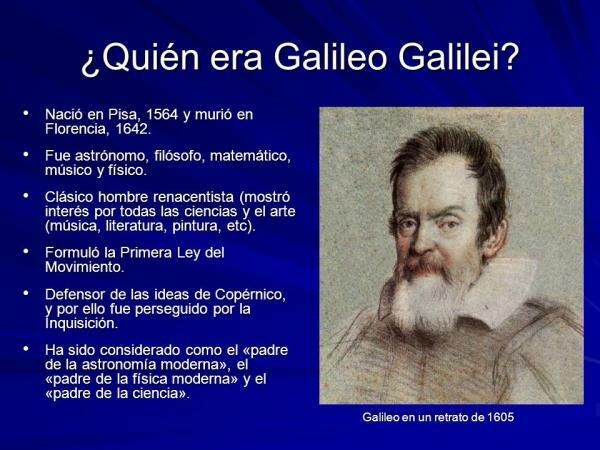
Image: SlidePlayer
To talk about Galileo Galilei most important discovery, we must know the scientific method of resolution-composition, being the method that Galileo used for his creations and discoveries, and that later was used by many scientists.
This method was based on 4 steps, which had to be followed to be sure that a discovery was totally real. The 4 guidelines are as follows.
- Observation: Apply the senses to the things that surround us.
- Elaboration of an explanatory hypothesis: A hypothesis is made about what has been observed, creating a new explanation that is not yet proven.
- Deduction: From the hypothesis we look at the consequences of its being true. These consequences must be mathematical, since Galileo thought that everything in this world was written in mathematical language.
- Experiment or verification: The conditions are provoked to see if the hypothesis is real, trying that there are no external factors, and it is seen if the same consequences occur in all cases.

Image: Notes of the subject - WordPress.com
The great historical importance of Galileo Galilei is based on the number of discoveries and inventions that are related to him, being one of the most prolific scientists in this regard. Next we must talk about the most important of the numerous discoveries of him.
Pendulum
Galileo discovered the oscillations of the pendulum, seeing that the oscillation of the pendulum was not due to the weight of the pendulum, but varied depending on the length of the arm.
Hydrostatic balance
This instrument made it possible to measure the weight of objects that had been submerged. Galileo was based for the creation of it on Archimedes' principle, and it was used to measure densities of solid and liquid objects.
Water thermometer
It was a kind of tube ending in a sphere. The open part was immersed in water and alcohol, and when heated the water rose through the tube, allowing the temperature to be known. This invention evolved into our current thermometers.
Telescope
Galileo was not the creator of the telescope, but he improved it to be able to see elements of space, using it to see the Moon and Jupiter. Thanks to this, he was able to make great astronomical discoveries, such as some of the moons of Jupiter or the demonstration of the heliocentric model of Copernicus.
Microscope
Although many people think that the microscope was an invention of Galileo, the reality is that he only took the model of Zacharias Janssen. The belief that Galileo invented it is due to the fact that he gave it great support, seeking its diffusion among scientists and trying to improve it.
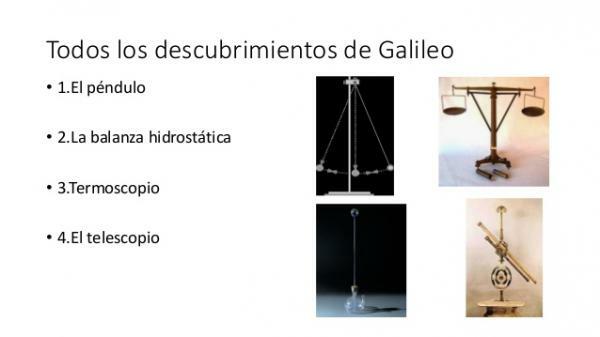
Image: propi.es
The laws and theories of Galileo were many and varied, although several of them were based on the works of previous authors. Some of his laws are as follows:
- Law of free fall: the speed of a body is independent of its mass, so all bodies fall at the same speed.
- Heliocentric Law: Galileo supported the Copernicus theory on the fact that the Earth was not the center of the universe and that it was the Sun on which all the stars revolved.
- Law of inertia: a body moving along the horizontal plane will move in a particular direction at a constant speed unless it is subjected to external interference. This law was later improved by Newton, and broke with the belief of Aristotle, that until that moment was the most accepted.
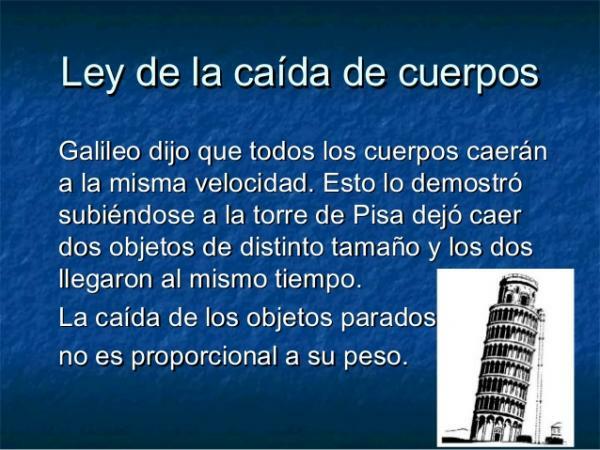
Image: Slideshare


